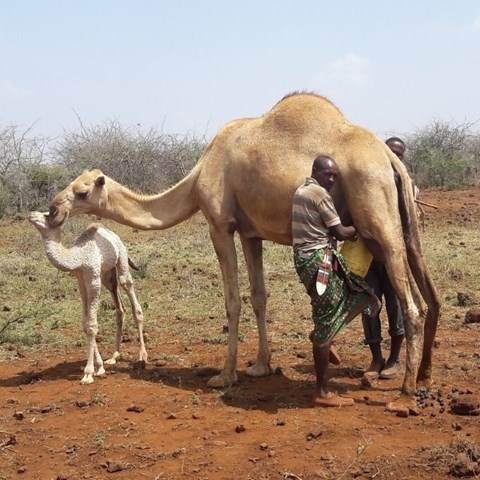Camels have long been kept as food producing animals by many pastoralist communities in the dryland areas around the Horn of Africa. Their resilience to the harsh climate makes them integral to food security in the region, primarily as producers of milk. Infection of the udder with Streptococcus (Str.) agalactiae, a contagious pathogen, is common among milking camels, and negatively affects milk production, animal and human health, as well as household income.
To curb disease transmission and improve the udder health of the camels, it is necessary to understand the mode of infection of Str. agalactiae. In a published study conducted in Kenya, potential transmission routes in camel herds were investigated. Samples were collected from milk and other body sites of the camels and the DNA content of the bacteria was analysed. The results revealed that in addition to finding Str. agalactiae in the milk, healthy camels commonly harboured the bacteria in their noses. The same bacterial strains could be found in milk and in the nose, and it was found that adult camels sometimes shared strains with their calves.
”It is possible that this bacteria can spread from the camels’ noses and infect the udder. Another potential route is via the calf to the udder of the mother when the calf is feeding. Previously, it was thought that Str. agalactiae was found exclusively in the udder and would spread between animals through poor hand hygiene of the milkers” says Dinah Seligsohn, one of the researchers who conducted the study. ”Now, we know that the nose of healthy camels can act as a reservoir for Str. agalactiae and may be involved in spreading and maintaining disease within camel herds.”.
Results:
- Str. agalactiae was detected in camel milk, in nose swabs from adult camels and calves, and in the mouth and rectum in camel calves.
- A quarter of the sampled camels were healthy carriers of Str. agalactiae in the nose.
- The same types of Str. agalactiae were found in milk and in other body sites.
- Multiple variants of this bacterium were found within the same herds.
The new knowledge needs to be considered when developing prevention and control strategies. “It is really striking what an important role the camels play to the residents in the drylands, especially as droughts are becoming more frequent. Building on the new results, we need to work on preventive measures adapted to the local context.” says Dinah Seligsohn.
Link to the scientific publication: https://doi.org/10.1371/journal.pone.0252973
This study was funded by the Swedish Research Council.
